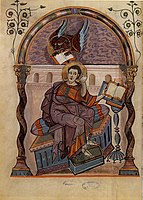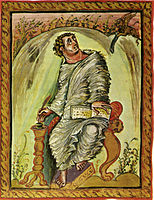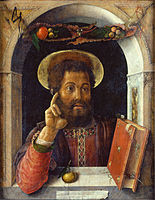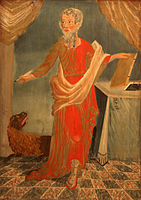Mark the Evangelist
Mark the Evangelist | |
|---|---|
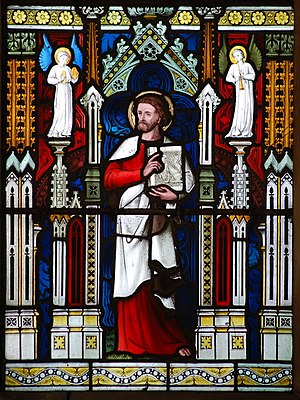 Detail from a window in the parish church of SS Mary and Lambert, Stonham Aspal, Suffolk, with stained glass representing St Mark the Evangelist | |
| Evangelist, Martyr | |
| Born | c. 12 AD Cyrene, Crete and Cyrenaica, Roman Empire (according to Coptic tradition)[1] |
| Died | c. 68 AD (aged c. 56) Alexandria, Egypt, Roman Empire |
| Venerated in | All Christian churches that venerate saints |
| Major shrine | |
| Feast |
|
| Patronage | Barristers, Venice,[2] Egypt, Copts,[3] Mainar, Podgorica[4] Pangil, Laguna |
| Major works | Gospel of Mark (attributed) |
Mark the Evangelist[lower-alpha 1] also known as John Mark or Saint Mark, is the person who is traditionally ascribed to be the author of the Gospel of Mark. Modern Bible scholars have concluded that the Gospel of Mark was written by an anonymous author rather than an identifiable historical figure. According to Church tradition, Mark founded the episcopal see of Alexandria, which was one of the five most important sees of early Christianity. His feast day is celebrated on April 25, and his symbol is the winged lion.[5]
Identity[edit]

According to William Lane (1974), an "unbroken tradition" identifies Mark the Evangelist with John Mark,[6] and John Mark as the cousin of Barnabas.[7] However, Hippolytus of Rome, in On the Seventy Apostles, distinguishes Mark the Evangelist (2 Timothy 4:11),[8] John Mark (Acts 12:12, 25; 13:5, 13; 15:37),[9] and Mark the cousin of Barnabas (Colossians 4:10;[10] Philemon 1:24).[11][12] According to Hippolytus, they all belonged to the "Seventy Disciples" who were sent out by Jesus to disseminate the gospel (Luke 10:1ff.)[13] in Judea.
According to Eusebius of Caesarea,[14] Herod Agrippa I, in his first year of reign over the whole of Judea (AD 41), killed James, son of Zebedee and arrested Peter, planning to kill him after the Passover. Peter was saved miraculously by angels, and escaped out of the realm of Herod (Acts 12:1–19).[15] Peter went to Antioch, then through Asia Minor (visiting the churches in Pontus, Galatia, Cappadocia, Asia, and Bithynia, as mentioned in 1 Peter 1:1),[16] and arrived in Rome in the second year of Emperor Claudius (AD 42).[17] Somewhere on the way, Peter encountered Mark and took him as travel companion and interpreter. Mark the Evangelist wrote down the sermons of Peter, thus composing the Gospel according to Mark,[18] before he left for Alexandria in the third year of Claudius (AD 43).[19]
According to the Acts 15:39,[20] Mark went to Cyprus with Barnabas after the Council of Jerusalem.
According to tradition, in AD 49, about 19 years after the Ascension of Jesus, Mark travelled to Alexandria and founded the Church of Alexandria. The Coptic Orthodox Church, the Greek Orthodox Church of Alexandria, and the Coptic Catholic Church all trace their origins to this original community.[21] Aspects of the Coptic liturgy can be traced back to Mark himself.[22] He became the first bishop of Alexandria and he is honored as the founder of Christianity in Africa.[23]
According to Eusebius,[24] Mark was succeeded by Anianus as the bishop of Alexandria in the eighth year of Nero (62/63), probably, but not definitely, due to his coming death. Later Coptic tradition says that he was martyred in 68.[1][25][26][27][11]
Modern Bible scholars (i.e. most critical scholars) have concluded that the Gospel of Mark was written by an anonymous author rather than by Mark.[28][29][30][31] For instance, the author of the Gospel of Mark knew very little about the geography of Palestine (having apparently never visited it),[32][33][34][35] "was very far from being a peasant or a fisherman",[32] was unacquainted with Jewish customs (unlikely for someone from Palestine),[34][35] and was probably "a Hellenized Jew who lived outside of Palestine".[36] Mitchell Reddish does concede that the name of the author might have been Mark (making the gospel possibly homonymous), but the identity of this Mark is unknown.[35] Similarly, "Francis Moloney suggests the author was someone named Mark, though maybe not any of the Marks mentioned in the New Testament".[37] The Routledge Encyclopedia of the Historical Jesus takes the same approach: the author was named Mark, but scholars are undecided who this Mark was.[34]
The four canonical gospels are anonymous and most researchers agree that none of them was written by eyewitnesses.[38][39][40][41] Some conservative researchers defend their traditional authorship, but for a variety of reasons most scholars have abandoned this theory or support it only tenuously.[42]
Biblical and traditional information[edit]
Evidence for Mark the Evangelist's authorship of the Gospel of Mark that bears his name originates with Papias (c. 60 – c. 130 AD).[43][44][45] Scholars of the Trinity Evangelical Divinity School are "almost certain" that Papias is referencing John Mark.[46] Modern mainstream Bible scholars find Papias's information difficult to interpret.[47]
The Coptic Church accords with identifying Mark the Evangelist with John Mark, as well as that he was one of the Seventy Disciples sent out by Jesus (Luke 10:1),[13] as Hippolytus confirmed.[48] Coptic tradition also holds that Mark the Evangelist hosted the disciples in his house after Jesus's death, that the resurrected Jesus came to Mark's house (John 20), and that the Holy Spirit descended on the disciples at Pentecost in the same house.[48] Furthermore, Mark is also believed to have been among the servants at the Marriage at Cana who poured out the water that Jesus turned to wine (John 2:1–11).[49][48]
According to the Coptic tradition, Mark was born in Cyrene, a city in the Pentapolis of North Africa (now Libya). This tradition adds that Mark returned to Pentapolis later in life, after being sent by Paul to Colossae (Colossians 4:10;[10] Philemon 24.)[50] Some, however, think these actually refer to Mark the Cousin of Barnabas), and serving with him in Rome (2 Timothy 4:11);[8] from Pentapolis he made his way to Alexandria.[51][52] When Mark returned to Alexandria, the pagans of the city resented his efforts to turn the Alexandrians away from the worship of their traditional gods.[53] In AD 68, they placed a rope around his neck and dragged him through the streets until he was dead.[53]
Veneration[edit]

The Feast of St Mark is observed on April 25 by the Catholic and Eastern Orthodox Churches. For those Churches still using the Julian calendar, April 25 according to it aligns with May 8 on the Gregorian calendar until the year 2099. The Coptic Orthodox Church observes the Feast of St Mark on Parmouti 30 according to the Coptic calendar which always aligns with April 25 on the Julian calendar or May 8 on the Gregorian calendar.
Where John Mark is distinguished from Mark the Evangelist, John Mark is celebrated on September 27 (as in the Roman Martyrology) and Mark the Evangelist on April 25.
Mark is remembered in the Church of England and in much of the Anglican Communion, with a Festival on 25 April.[54]
In art[edit]
Mark the Evangelist is most often depicted writing or holding his gospel.[55] In Christian tradition, Mark the Evangelist is symbolized by a winged lion.[56]
Mark the Evangelist attributes are the lion in the desert; he can be depicted as a bishop on a throne decorated with lions; as a man helping Venetian sailors. He is often depicted holding a book with pax tibi Marce written on it or holding a palm and book. Other depictions of Mark show him as a man with a book or scroll, accompanied by a winged lion. The lion might also be associated with Jesus' Resurrection because lions were believed to sleep with open eyes, thus a comparison with Christ in his tomb, and Christ as king.
Mark the Evangelist can be depicted as a man with a halter around his neck and as rescuing Christian slaves from Saracens.
- Depictions of Mark the Evangelist
-
Venetian merchants with the help of two Greek monks take Mark the Evangelist's body to Venice, by Tintoretto
-
Mark the Evangelist listening to the winged lion, Mark; image 21 of the Codex Aureus of Lorsch or Lorsch Gospels
-
Mark the Evangelist looking at the lion, c. 823
-
The martyrdom of Saint Mark. Très Riches Heures du duc de Berry (Musée Condé, Chantilly), c. 1412 and 1416.
-
St Mark by Andrea Mantegna, 1448
-
Mark the Evangelist with the lion, 1524
-
A painted miniature in an Armenian Gospel manuscript from 1609, held by the Bodleian Library
-
Saint Mark on a 17th-century naive painting by unknown artist in the choir of St Mary church (Sankta Maria kyrka) in Åhus, Sweden
-
St. Mark writes his Evangelium at the dictation of St. Peter, by Pasquale Ottino, 17th century, Beaux-Arts, Bordeaux
-
Mark the Evangelist by Il Pordenone (c. 1484–1539)
-
Saint Mark the Evangelist Icon from the royal gates of the central iconostasis of the Kazan Cathedral in Saint Petersburg, 1804
-
An icon of Saint Mark the Evangelist, 1657
-
St Mark in the Nuremberg Chronicle
-
Saint Mark, 1411–1413, by Donatello (Orsanmichele, Florence)
-
Coptic icon of Saint Mark the Evangelist
Major shrines[edit]
- Basilica di San Marco (Venice, Italy)
- Saint Mark's Coptic Orthodox Cathedral (Alexandria, Egypt)
- Saint Mark's Church (Serbian Orthodox) in Belgrade, Serbia
- Saint Mark's Coptic Orthodox Cathedral (Cairo, Egypt)
- St. Mark's Church in-the-Bowery, New York City
- St. Mark The Evangelist Parish Church, Pangil, Laguna, Philippines
- St. Mark The Evangelist Parish, Linao, Ormoc City,
See also[edit]
Notes[edit]
- ↑ ; ; ; ; .
References[edit]
Citations[edit]
- ↑ 1.0 1.1 "St. Mark The Apostle, Evangelist". Coptic Orthodox Church Network. Retrieved November 21, 2012.
- ↑ Walsh, p. 21.
- ↑
- ↑ "Markovdan: Slava Podgorice". Borba. May 8, 2023.
- ↑ Senior, Donald P. (1998), "Mark", in Ferguson, Everett (ed.), Encyclopedia of Early Christianity (2nd ed.), New York and London: Garland Publishing, Inc., p. 720, ISBN 0-8153-3319-6
- ↑
- ↑ Mark: Images of an Apostolic Interpreter p55 C. Clifton Black – 2001 –"... infrequent occurrence in the Septuagint (Num 36:11; Tob 7:2) to its presence in Josephus (JW 1.662; Ant 1.290, 15.250) and Philo (On the Embassy to Gaius 67), anepsios consistently carries the connotation of "cousin", though ..."
- ↑ 8.0 8.1 2 Timothy 4:11
- ↑ Acts 12:12–25, Acts 13:5–13, Acts 15:37
- ↑ 10.0 10.1 Colossians 4:10
- ↑ 11.0 11.1 Philemon 1:24
- ↑
- ↑ 13.0 13.1 Luke 10:1
- ↑ The Ecclesiastical History 2.9.1–4
- ↑ Acts 12:1–19
- ↑ 1 Peter 1:1
- ↑ The Ecclesiastical History 2.14.6
- ↑ The Ecclesiastical History 15–16
- ↑
- ↑ Acts 15:39
- ↑ "Egypt". Berkley Center for Religion, Peace, and World Affairs. Archived from the original on December 20, 2011. Retrieved December 14, 2011. See drop-down essay on "Islamic Conquest and the Ottoman Empire"
- ↑ "The Christian Coptic Orthodox Church Of Egypt". Encyclopedia Coptica. Archived from the original on August 31, 2005. Retrieved 26 January 2018.
- ↑
- ↑ The Ecclesiastical History 2.24.1
- ↑ "Catholic Encyclopedia, St. Mark". Retrieved March 1, 2013.
- ↑ Acts 15:36–40
- ↑ 2 Timothy 4:11
- ↑
- ↑
- ↑
- ↑
- ↑ 32.0 32.1
- ↑
- ↑ 34.0 34.1 34.2
- ↑ 35.0 35.1 35.2 Reddish 2011, p. 36: "Evidence in the Gospel itself has led many readers of the Gospel to question the traditional view of authorship. The author of the Gospel does not seem to be too familiar with Palestinian geography. [...] Is it likely that a native of Palestine, as John Mark was, would have made such errors?" [...] Also, certain passages in the Gospel contain erroneous statements about Palestinian or Jewish practices."
- ↑
- ↑
- ↑
- ↑ Reddish 2011, pp. 13, 42.
- ↑ Cousland 2010, p. 1744.
- ↑ Cousland 2018, p. 1380.
- ↑ Lindars, Edwards & Court 2000, p. 41.
- ↑ "From Stories to Canon" (PDF). Archived from the original (PDF) on 2016-07-05. Retrieved 2023-08-20.
- ↑
- ↑ Harrington, Daniel J. (1990), "The Gospel According to Mark", in Brown, Raymond E.; Fitzmyer, Joseph A.; Murphy, Roland E. (eds.), The New Jerome Biblical Commentary, Englewood Cliffs, New Jersey: Prentice Hall, p. 596, ISBN 0-13-614934-0
- ↑ D. A. Carson, Douglas J. Moo and Leon Morris, An Introduction to the New Testament (Apollos, 1992), 93.
- ↑
- ↑ 48.0 48.1 48.2 Pope Shenouda III, The Beholder of God Mark the Evangelist Saint and Martyr, Chapter One. Tasbeha.org
- ↑ John 2:1–11
- ↑ Philemon 24
- ↑ "About the Diocese". Coptic Orthodox Diocese of the Southern United States.
- ↑ "Saint Mark". Retrieved May 14, 2009.
- ↑ 53.0 53.1 Pope Shenouda III. The Beholder of God Mark the Evangelist Saint and Martyr, Chapter Seven. Tasbeha.org
- ↑ "The Calendar". The Church of England. Retrieved 2021-03-27.
- ↑
- ↑ "St. Mark in Art". www.christianiconography.info.
Bibliography[edit]
Script error: No such module "navboxes". Template:Patriarchs of AlexandriaScript error: No such module "navboxes". Script error: No such module "subject bar".

